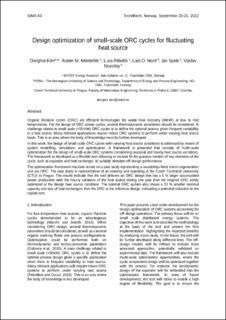| dc.contributor.author | Kim, Donghoi | |
| dc.contributor.author | Mocholí Montañés, Rubén | |
| dc.contributor.author | Riboldi, Luca | |
| dc.contributor.author | Nord, Lars Olof | |
| dc.contributor.author | Spale, Jan | |
| dc.contributor.author | Novotny, Vaclav | |
| dc.date.accessioned | 2022-11-03T09:16:38Z | |
| dc.date.available | 2022-11-03T09:16:38Z | |
| dc.date.created | 2022-10-31T08:46:58Z | |
| dc.date.issued | 2022 | |
| dc.identifier.citation | Proceedings of the 63rd International Conference of Scandinavian Simulation Society, SIMS 2022, Trondheim, Norway, September 20-21, 2022 | en_US |
| dc.identifier.isbn | 978-91-7929-545-5 | |
| dc.identifier.issn | 1650-3740 | |
| dc.identifier.uri | https://hdl.handle.net/11250/3029756 | |
| dc.description.abstract | Organic Rankine cycles (ORC) are efficient technologies for waste heat recovery (WHR) at low to mid temperatures. For the design of ORC power cycles, several thermodynamic parameters should be considered. A challenge related to small scale (<50 kW) ORC cycles is to define the optimal process given frequent variability in a heat source. Many relevant applications require robust ORC systems to perform under varying heat source loads. This is an area where the body of knowledge must be further developed.
In this work, the design of small-scale ORC cycles with varying heat source conditions is addressed by means of system modelling, simulation, and optimization. A framework is presented that consists of multi-scale optimization for the design of small-scale ORC systems considering seasonal and hourly heat source variations. The framework is developed as a flexible tool allowing to include fit-for-purpose models of key elements of the cycle, such as expander and heat exchanger, to suitably simulate off-design performance.
The optimization framework has been tested on a case study representing a woodchips-fired micro-cogeneration unit via ORC. The case study is representative of an existing unit operating at the Czech Technical University (CTU) in Prague. The results indicate that the tool delivers an ORC design that has a 5 % larger accumulated power production with the hourly variation of the heat source during one year than the original ORC solely optimized at the design heat source condition. The optimal ORC system also shows a 33 % smaller nominal capacity and size of heat exchangers than the ORC at the reference design, indicating a potential reduction in the capital cost. | en_US |
| dc.language.iso | eng | en_US |
| dc.relation.ispartof | Proceedings of the 63rd International Conference of Scandinavian Simulation Society, SIMS 2022, Trondheim, Norway, September 20-21, 2022 | |
| dc.relation.ispartofseries | Linköping Electronic Conference Proceeding;192 | |
| dc.rights | Navngivelse 4.0 Internasjonal | * |
| dc.rights.uri | http://creativecommons.org/licenses/by/4.0/deed.no | * |
| dc.title | Design optimization of small-scale ORC cycles for fluctuating heat source | en_US |
| dc.title.alternative | Design optimization of small-scale ORC cycles for fluctuating heat source | en_US |
| dc.type | Chapter | en_US |
| dc.type | Peer reviewed | en_US |
| dc.type | Journal article | en_US |
| dc.description.version | publishedVersion | en_US |
| dc.rights.holder | The Authors | en_US |
| dc.identifier.doi | 10.3384/ecp192029 | |
| dc.identifier.cristin | 2066546 | |
| cristin.ispublished | true | |
| cristin.fulltext | original | |
| cristin.qualitycode | 1 | |

